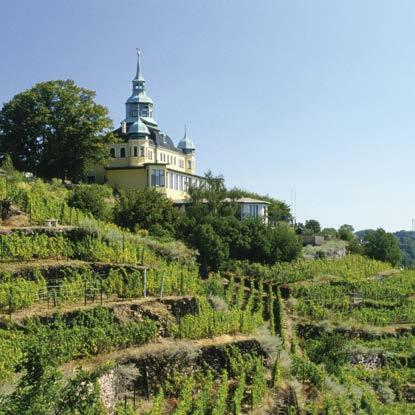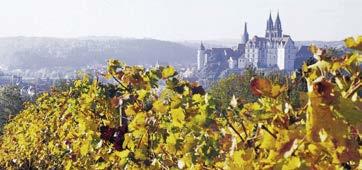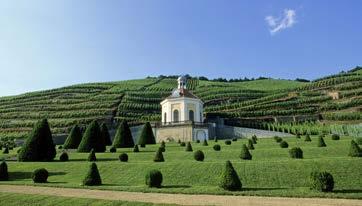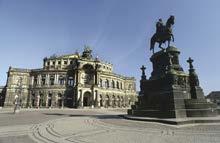
6 minute read
Sachsen
SPECIALTIES AND RARITIES
Sachsen is the northeastenmost and one of the smallest of Germany’s wine-growing regions. The vineyards begin near Dresden, on the 51st degree of latitude, and stretch along the Elbe River just beyond Meissen. Sachsen’s viticultural tradition spans more than eight centuries, first documented in 1161. In its heyday in the 17th century, the vineyard are comprised 5,000 ha (12,355 acres) – today, about 500 ha (1,235 acres).
Advertisement
Meissen, home of a world-renowned porcelain manufactory, is considered to be the cradle of Saxon viticulture, and today, site of the region’s largest wine festival. Temporal and spiritual authorities cared for the vines for centuries. They built castles, hillside residences, and summer houses, as well as vintners’ huts, churches in vineyards and wine pubs – thus creating a connection

between architecture and viticulture that is typical of the region to this day.
The climate in Sachsen is particularly favorable, which is why it is possible to produce top-quality wines, particularly white wines, despite its northeasterly location. with its 1,600 hours of sunshine every year, the continental climate provides optimal conditions for grapes to grow and ripen, provided there is sufficient precipitation. The constant changes in temperature – warm days and cool nights – promotes the development of rich aromas in the wines.
Sachsen wines are rarities. They are found primarily within the region – in cozy wine pubs and upscale restaurants, in stylish Vinotheks (shops) and at autumn

wine festivals – and, of course at the estates where they are produced. These outlets are all at home on the Sachsen wine road, a 55-km (34-mile) route from Pirna to the idyllic wine villages on the elbe near diesbar-Seusslitz, and passes through dresden, radebeul and Meissen along the way. It connects the region’s cultural-historical sights and a charming landscape marked by viticultural gems, such as the steep vineyards on quarrystone terraces. The great wines of the region, e.g. weissburgunder (Pinot Blanc), Grauburgunder (Pinot Gris) and above all, Traminer, thrive on the steep slopes lining the elbe. The 90-km (56-mile) “Sächsische weinwanderweg” not only takes in all the sights of the region, but also leads hikers to the most beautiful vineyards, as well as vantage points and wine cellars.
Vsitors can drop in for a glass of wine and a hearty meal at any number of rustic wine pubs, popular places that are usually operated by part-time or hobby vintners. For those who want to learn more about work in the vineyards or cellars can spend a vacation at a vintner’s home or attend the “open house” the last weekend in August, when more than 25 estates open their cellar doors to the public and offer vineyard tours and tast-
SACHSEN – AT A GLANCE
Geographical location: Situated in the elbe river Valley between Pirna and diesbar-Seusslitz (55 km/34 miles), with islands of vineyards in the elsteral (Sachsen-Anhalt) and Schlieben (Brandenburg) · Climate: Mild annual temperatures in a continental climate, medium rainfall · Soils: Predominantly granite and weathered granite prophyry soils, but also loam, loess and sandstone · Size: ca. 500 ha (1,250 acres) · Grape varieties: Müller-Thurgau, riesling, weissburgunder (Pinot Blanc), Grauburgunder (Pinot Gris)
ings. Müller-Thurgau, riesling and weissburgunder are always on offer, but also some rarities, such as elbling and Gutedel. In all, there are about two dozen varietals cultivated in the region. Insider’s tip: try a Goldriesling – a specialty grown only in Sachsen.
Information: Weinbauverband Sachsen e. V. Fabrikstraße 16 01662 Meißen Tel. +49 (0)3521 7635-30 Fax +49 (0)3521 7635-40 www.weinbauverband-sachsen.de info@weinbauverband-sachsen.de

Sachsen: Landmarks of German Wine Culture
SCHLOSS WACKERBARTH, SACHSEN
The present's role as a mirror into the past is never clearer than at Saxony's Staatsweingut Schloss Wackerbarth. Between 1999 and 2002 the Baroque castle and gardens were expanded to include a modern winery for still and sparkling wines. The building's clear lines and strong degree of transparency stand in conscious contrast to the playful Baroque buildings with their Rococo tones. The two styles represent equal but opposite poles – a symbol for viticulture on the Elbe that pays homage to tradition even as it moves self-confidently into the future.
Baroque Splendor, Contemporary Transparency The origins of Schloss wackerbarth lay in the time of Augustus II the Strong. His General Field Marshal and Minister of State, reichsgraf August Christoph von wackerbarth, arranged in 1730 for a retirement residence to be built for himself just outside the dresden city gates. He hired two feted master builders for the job: Johann Christoph Knöffel, the primary proponent of Saxon rococo, designed the castle, while Matthäus daniel Pöppelmann, the creator of dresden's famous Zwinger Palace, created the belvedere above the vineyard terraces. even then Schloss wackerbarth was surrounded by vineyards. Today the grounds in the Niederlößnitz district of radebeul welcome visitors to experience the winery up-close and personal. The syenite, limestone and granite soils, with some layers of loess clay, are home to riesling, Traminer, weißburgunder (Pinot Blanc), Goldriesling and Blaufränkisch grapes, as well as Scheurebe, dornfelder, Bacchus, Kerner, Grauburgunder (Pinot Gris) and Frühburgunder (Pinot Noir Précoce). This broad spectrum of varieties is typical for Sachsen wines, as is the cold-hardy Goldriesling – a Saxon specialty grown almost nowhere else.
Sächsisches Staatsweingut, Schloss Wackerbarth radebeul, wackerbarthstraße 1 Tel. +49 (0)351 89550 www.schloss-wackerbarth.de
HOFLÖSSNITZ IN THE HISTORICAL VINEYARD LANDSCAPE OF RADEBEUL, SACHSEN
Amidst the sun-kissed vineyards of the Saxon Wine Route stand the gates to Hoflößnitz, the famed historical estate near Radebeul. Top-quality wine has been produced on the Lößnitz slopes northwest of Dresden for over 600 years. It all started in 1401, when William the One-Eyed, Margrave of Meißen, purchased the area above the Lößnitzbach River – including the existing vineyards there.
Cradle of Saxon Viticulture For the next 500 years the estate remained in the possession of the wettin princes who ruled in Saxony until 1918. Under the reign of Augustus II the Strong in particular, the site was host to many noisy parties; the Baroque Himmelsleiter – the longest set of stairs in Saxony, connecting the vineyard terraces to Hoflößnitz – dates back to this period.
After the catastrophic phylloxera blight of the 19th century, it appeared that winemaking in the elbe Valley had run its course... until enologist Carl Pfeiffer began a systematic re-planting of the terraces in 1913. As the director of the College for Viticulture and winegrowing established in 1927 in Hoflößnitz, Pfeiffer developed marketing strategies intended to raise awareness around Germany for wines from the elbe. This climaxed in 1931 with the invention of the “Sachsenkeule” – a green wine bottle in an elegant ‘club’ shape considered

by many elbe Valley winemakers then and now to be a proud hallmark for Sachsen wines. In 1998 Hoflößnitz became the first estate in Saxony to achieve certification for ecological winemaking. It continues to apply those principles to its 8.5 hectares (21 acres) of vineyards. The estate’s still and sparkling wines can be tasted and purchased in the winery shop.
Stiftung Hoflößnitz radebeul, Knohllweg 37 Tel. +49 (0)351 8398341 www.hofloessnitz.de










